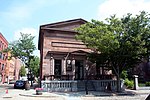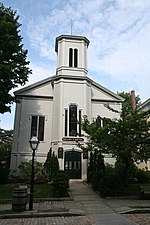South Coast (Massachusetts)

The South Coast of Massachusetts (sometimes stylized SouthCoast) is the region of southeastern Massachusetts consisting of the southern Bristol and Plymouth counties, bordering Buzzards Bay, and includes the cities of Fall River, New Bedford, the southeastern tip of East Taunton and nearby towns. The Rhode Island towns of Tiverton and Little Compton, located in Newport County, are often included within the South Coast designation due to regional similarities with adjacent communities. The term is recent, dating to the 1990s, and sometimes confused with the South Shore (a region southeast of Boston that includes eastern Norfolk and Plymouth counties, and does not overlap with the South Coast).
Excerpt from the Wikipedia article South Coast (Massachusetts) (License: CC BY-SA 3.0, Authors, Images).South Coast (Massachusetts)
Pine Street, New Bedford
Geographical coordinates (GPS) Address Nearby Places Show on map
Geographical coordinates (GPS)
| Latitude | Longitude |
|---|---|
| N 41.63 ° | E -70.92 ° |
Address
Pine Street 1;3
02740 New Bedford
Massachusetts, United States
Open on Google Maps









